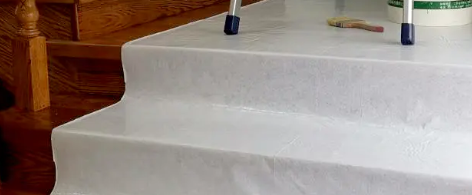Cat:Glue -coated Protective Film
● Protects carpet against staining, paint spillage and dirt during painting, building, remodeling, plastering, tiling, decoration, general maintenance...
See Details
Tile floors are widely used in homes, commercial spaces, and public areas due to their elegant appearance, durability, and ease of cleaning. However, during renovation, moving, construction, or cleaning, tile floors are vulnerable to mechanical damage, liquid spills, and stains, which can not only affect the floor’s aesthetic but also lead to long-term damage. Therefore, using specialized protective materials is crucial. Breathable Surface Protection Felt is an efficient, eco-friendly floor protection material that plays a significant role in these scenarios.
When selecting breathable surface protection felt, it is important to ensure that the product offers sufficient protective performance and is suitable for your type of tile floor. There are various types of protection felt available in the market, but not all are suited to your needs. Breathable surface protection felt has several key features, including high breathability, water resistance, stain resistance, durability, and ease of installation.
One of the main advantages of breathable surface protection felt is its superior breathability. The felt is made from non-woven synthetic felt combined with a PE film, with a breathable PE membrane adhered to the surface and self-adhesive glue on the back. This PE membrane effectively blocks liquids such as water, paint, and solvents from penetrating, while its breathability ensures the tile floor will not suffer from mold due to moisture buildup. Test results show that the 24-hour permeability rate of breathable surface protection felt can reach 1200 milliliters per square meter, indicating its ability to keep the floor dry while allowing air circulation, thus preventing moisture-related damage.
Breathable surface protection felt not only provides protective functions but is also highly durable. Whether subjected to heavy material handling during construction or resistant to scratches from sharp objects, the felt maintains excellent protective performance. Additionally, this product is eco-friendly and harmless, meeting modern construction industry’s requirements for green building materials. By using breathable surface protection felt, you reduce the spread of contaminants and ensure that your floor is not harmed by chemicals during construction.
Another significant advantage of breathable surface protection felt is its simple installation and removal process. With its self-adhesive glue on the back, you can easily lay it down without the need for tape or other additional tools. Just unfold the felt and gently press it onto the surface, and it will adhere securely. Furthermore, it is reusable, which helps you save costs.

Before using breathable surface protection felt, it is crucial to ensure the tile floor is clean and dry. If the floor has dust, grease, or other debris, it may affect the adhesive strength of the protection felt, potentially leading to floor damage. To ensure the best results, follow these steps for floor cleaning:
First, use a vacuum cleaner to thoroughly clean the floor, removing dust and small debris. Dust and debris can not only affect the adhesive strength of the protection felt but may also cause scratches between the felt and the tiles, leading to unnecessary damage.
For grease stains and stubborn dirt, use a damp cloth to gently wipe the surface, ensuring that any stains on the floor are removed. Avoid using strong chemical cleaners as they may affect the surface of the tiles.
After cleaning, ensure the floor is completely dry. A wet floor can prevent the breathable surface protection felt from adhering effectively, so it is important to keep the floor dry and free of moisture.
Laying the breathable surface protection felt is a key step in protecting the tile floor. Since the back of the felt is self-adhesive, the installation process is very simple, requiring no tape or additional materials.
| Feature | Breathable Surface Protection Felt | Traditional Protection Materials |
|---|---|---|
| Water Resistance | Excellent, blocks water, paint, and solvents effectively | Moderate, may require additional waterproof layer |
| Breathability | Excellent, allows floor to breathe, preventing mold | Poor, prone to water accumulation |
| Durability | High, reusable, scratch-resistant, pressure-resistant | Low, prone to damage |
| Environmental Friendliness | Eco-friendly | May contain harmful substances |
| Ease of Installation | Very easy, no tape required, self-adhesive | Complex, requires tape or fixators |
| Cleaning | Easy to clean, can be wiped or vacuumed | Harder to clean |
When laying the breathable surface protection felt, it is important to ensure the felt is laid flat without air bubbles or wrinkles. Air bubbles could affect the protective function, and water may accumulate beneath the felt, which would reduce its protection performance. To avoid wrinkles, make sure the felt is not excessively stretched during installation, especially if the felt is laid for a long period, which may cause creases and wrinkles.
For large areas, it is recommended to leave a small margin along the edges for easy finishing. Try not to lay the felt too tightly against the corners or furniture, as this can cause difficulty when removing it later. When trimming the edges using a cutting tool, avoid excessive pulling on the felt, as this can cause edge damage.
In addition to preventing stains and liquid penetration, breathable surface protection felt also protects against scratches caused by heavy objects. During construction or while moving furniture, try to avoid applying excessive pressure on the protection felt, especially when handling sharp objects. If additional protection is needed, you can place an extra layer of cushioning material on top of the felt to enhance its protective function.
Once the construction or renovation work is completed, carefully remove the breathable surface protection felt. Because the felt has self-adhesive glue on the back, it will not leave residue or sticky substances on the floor, making it very easy to clean up. You can wash it and store it for reuse, ensuring its durability and extending its lifespan.